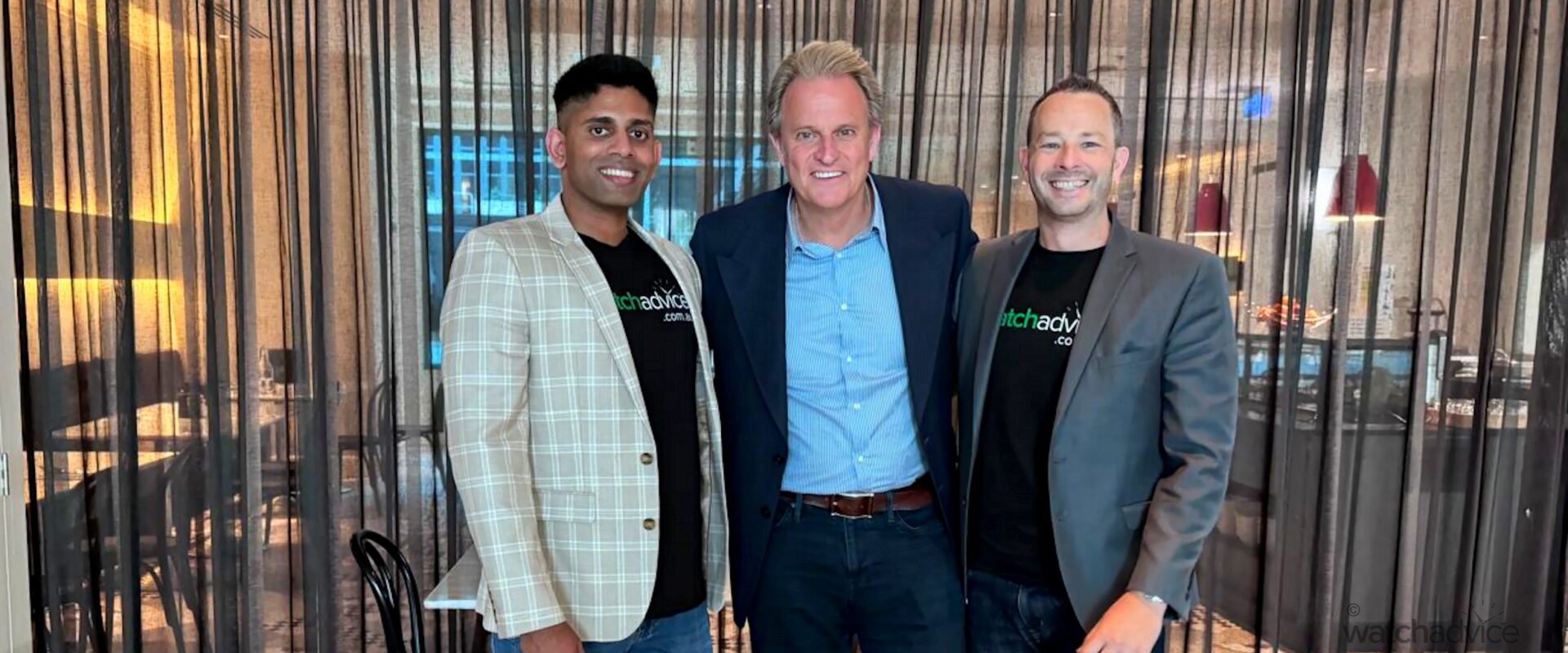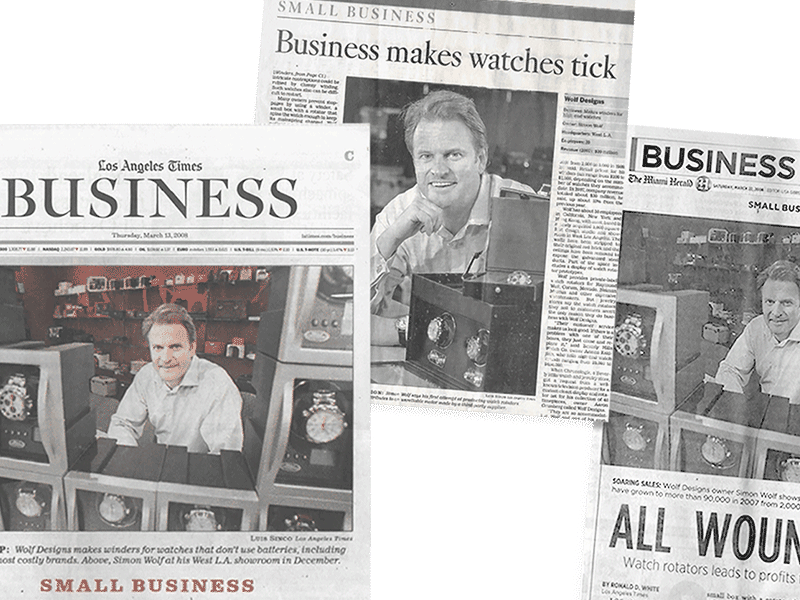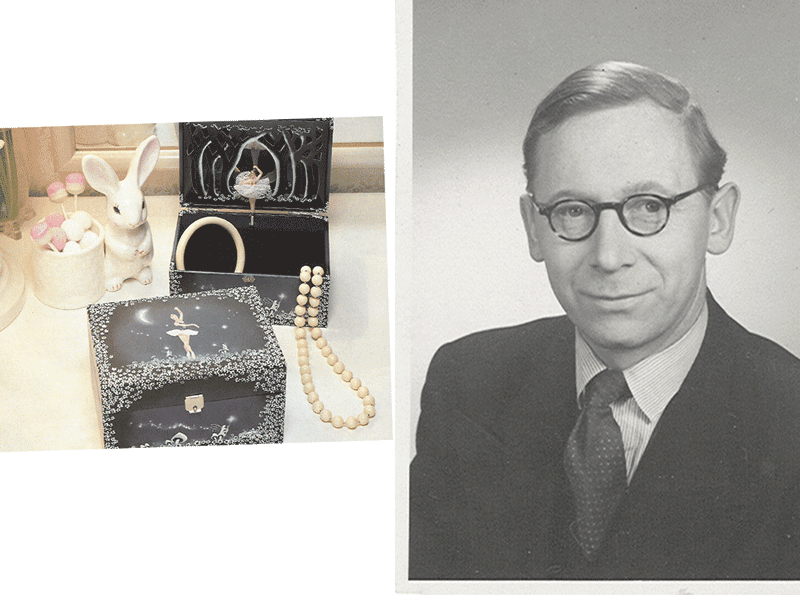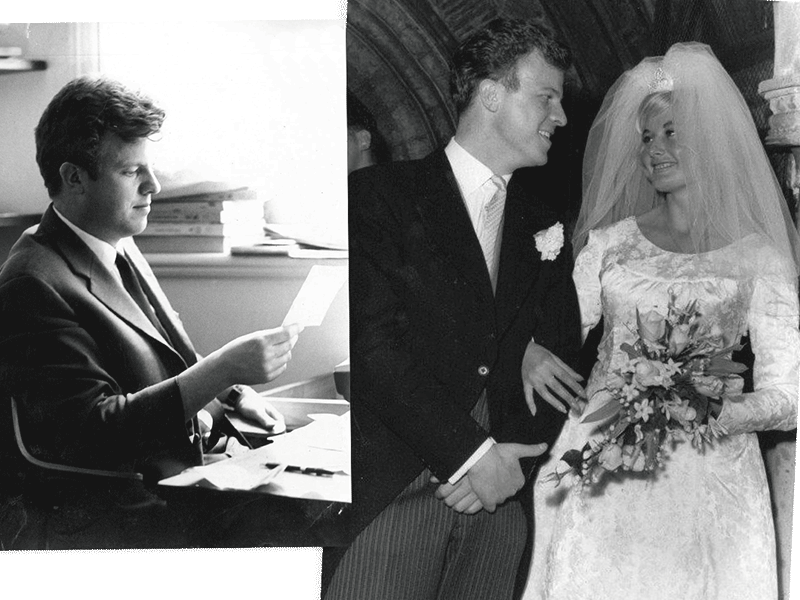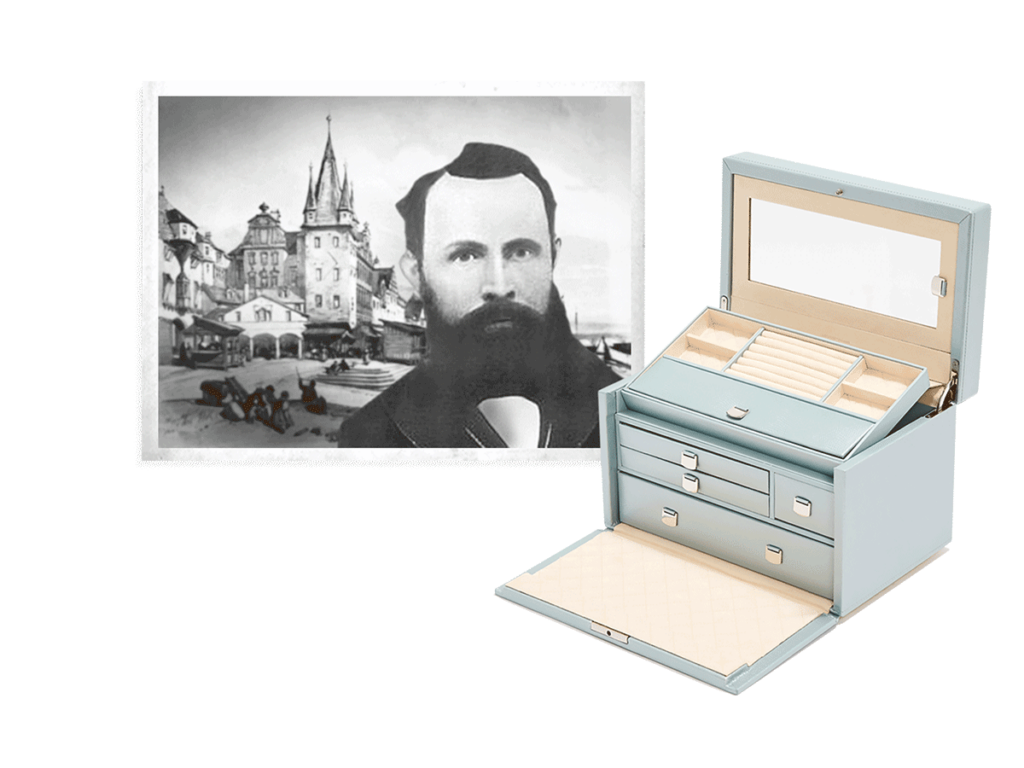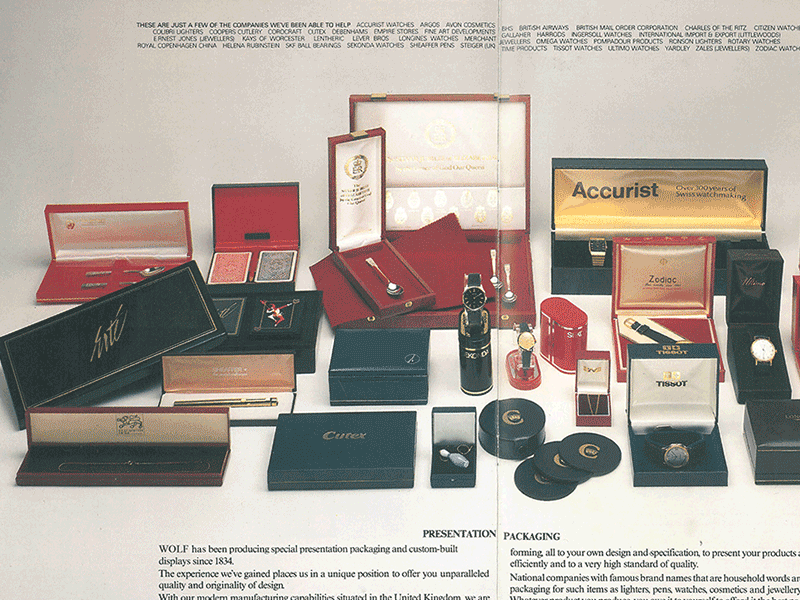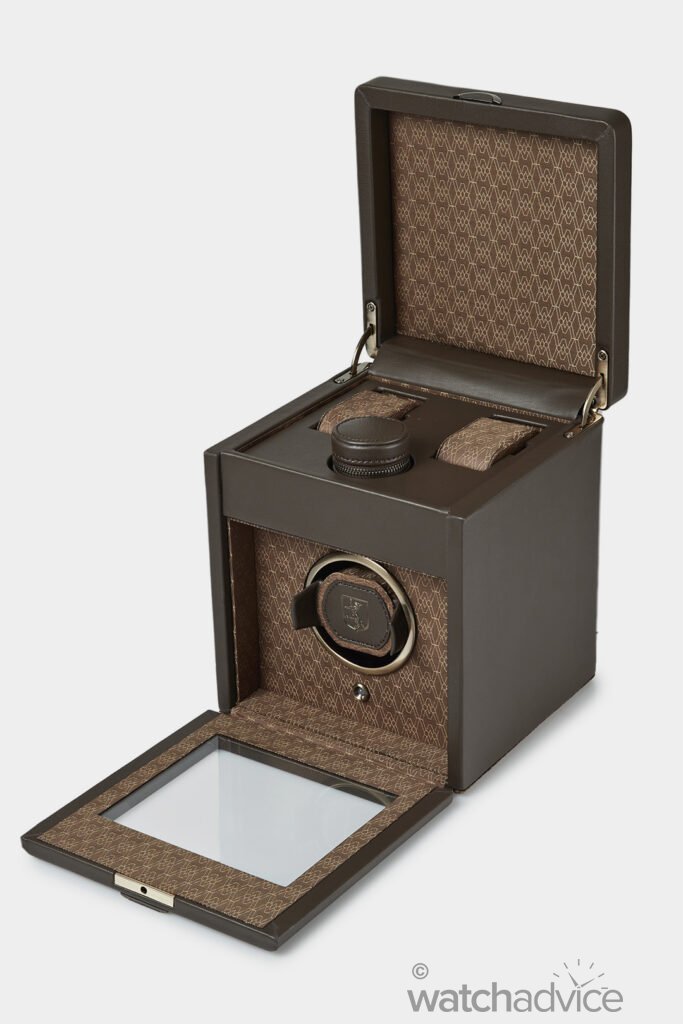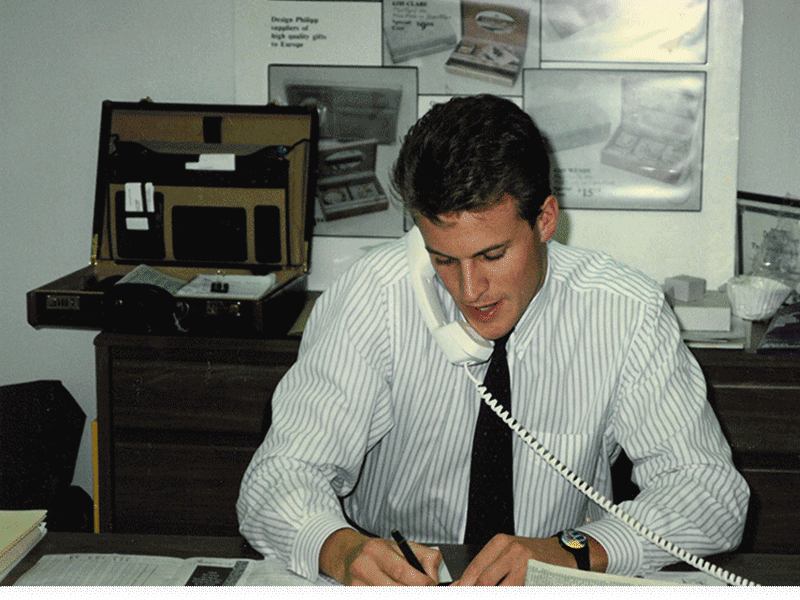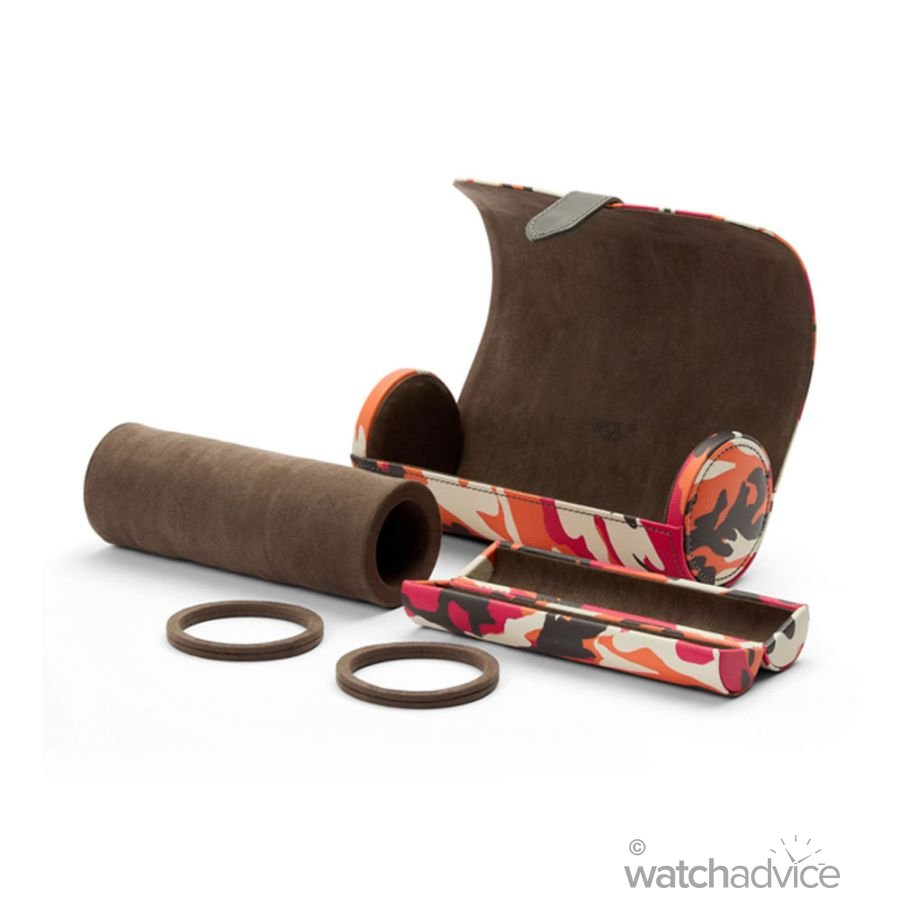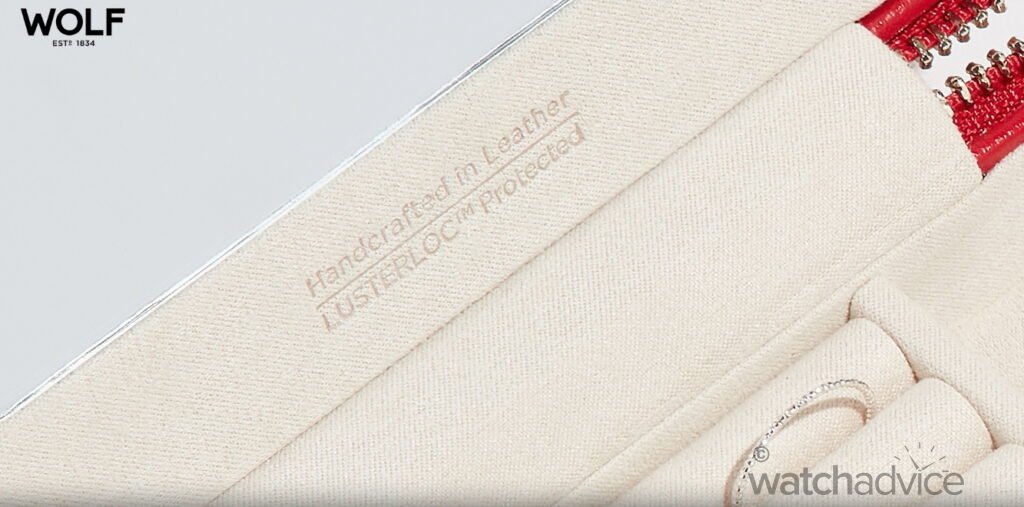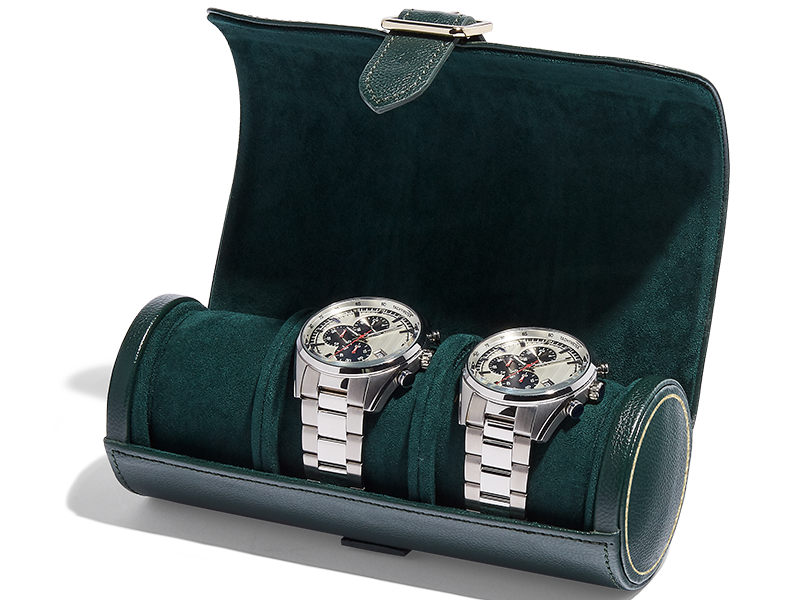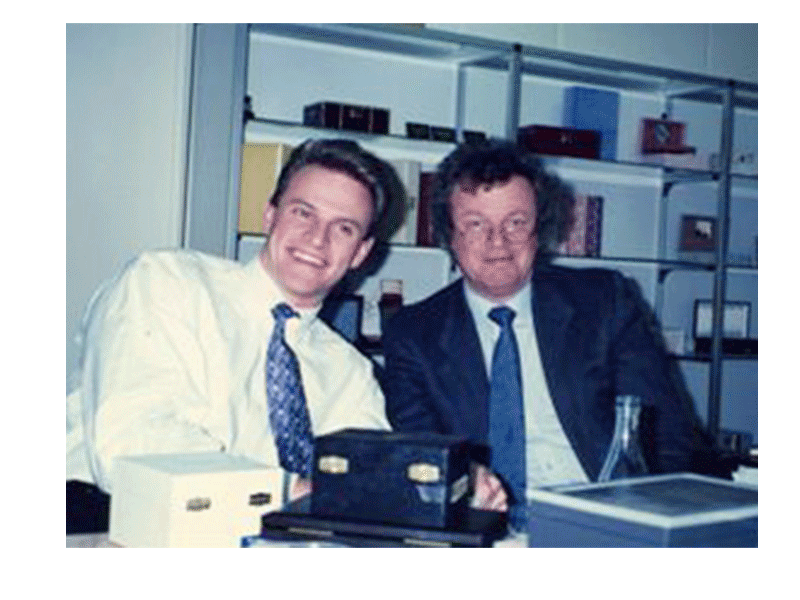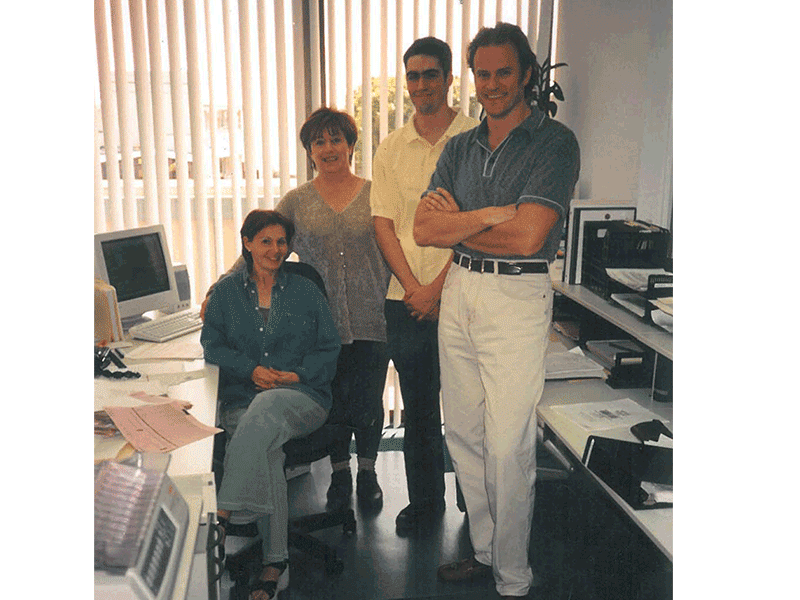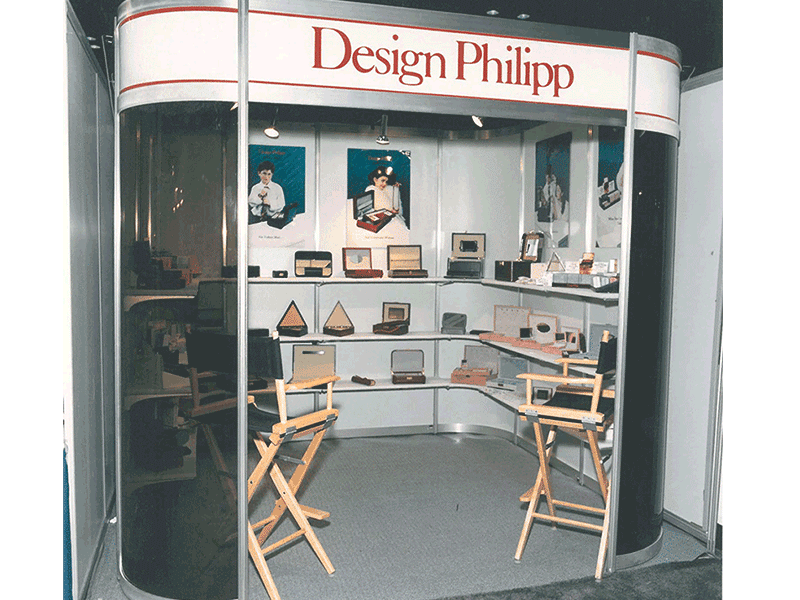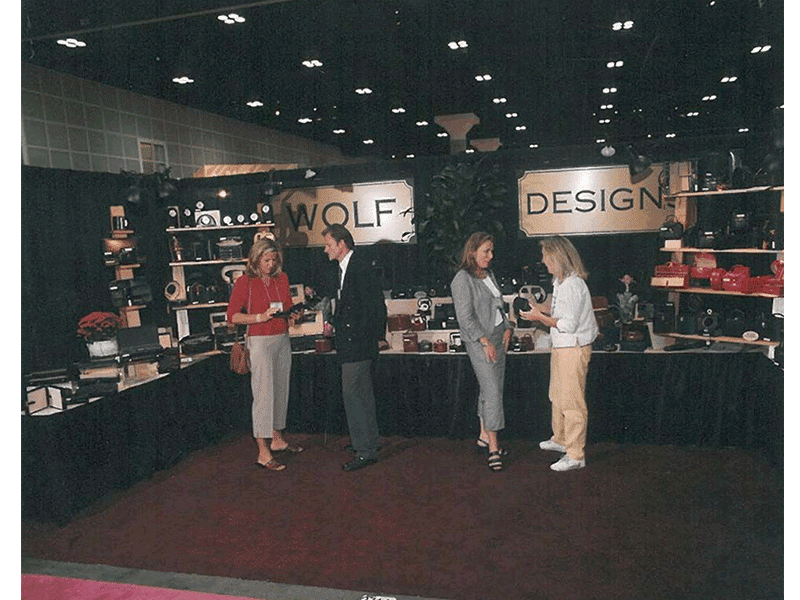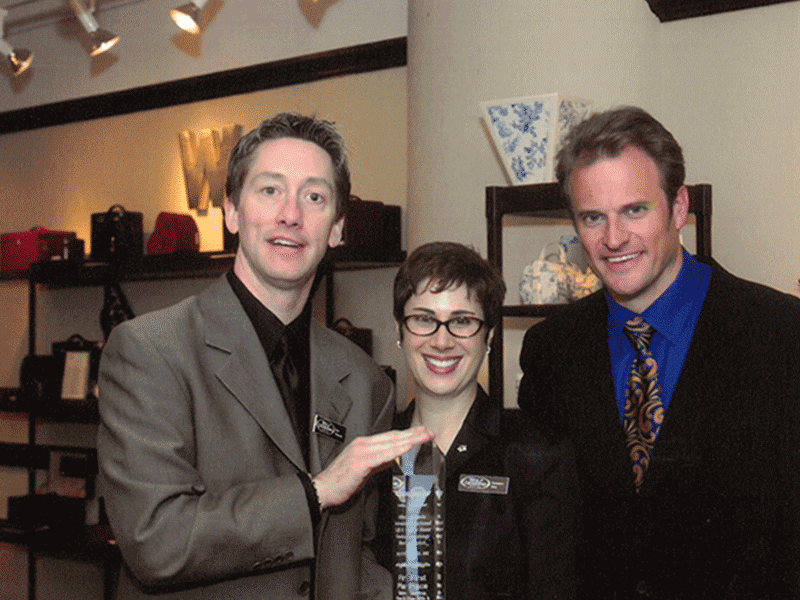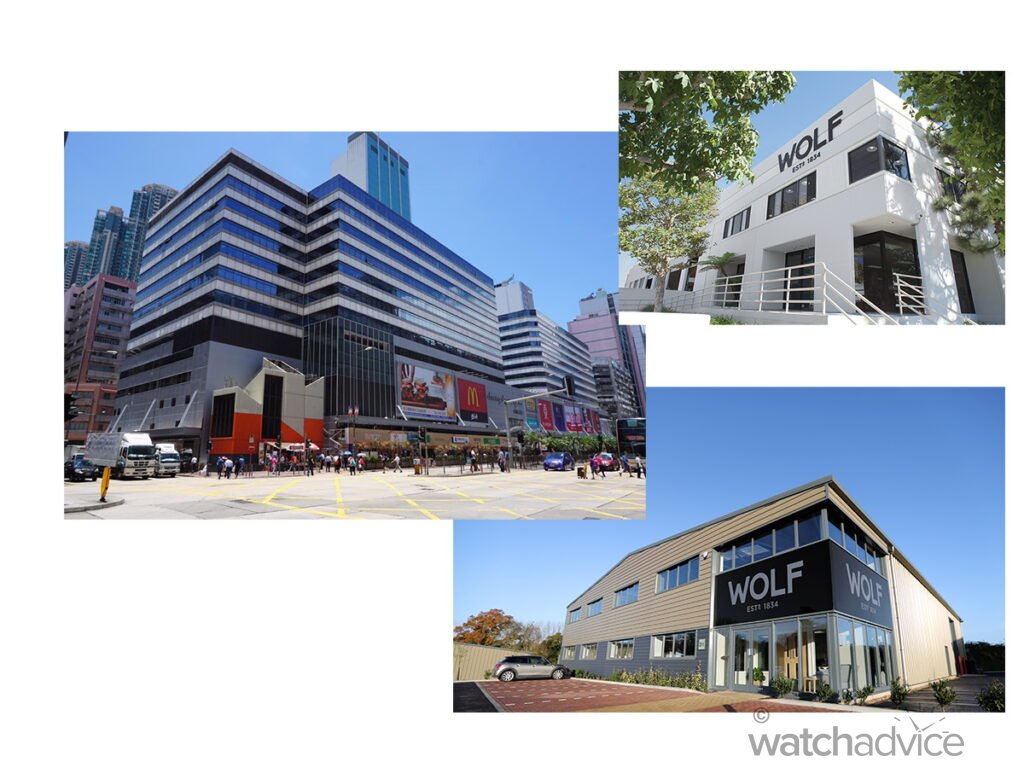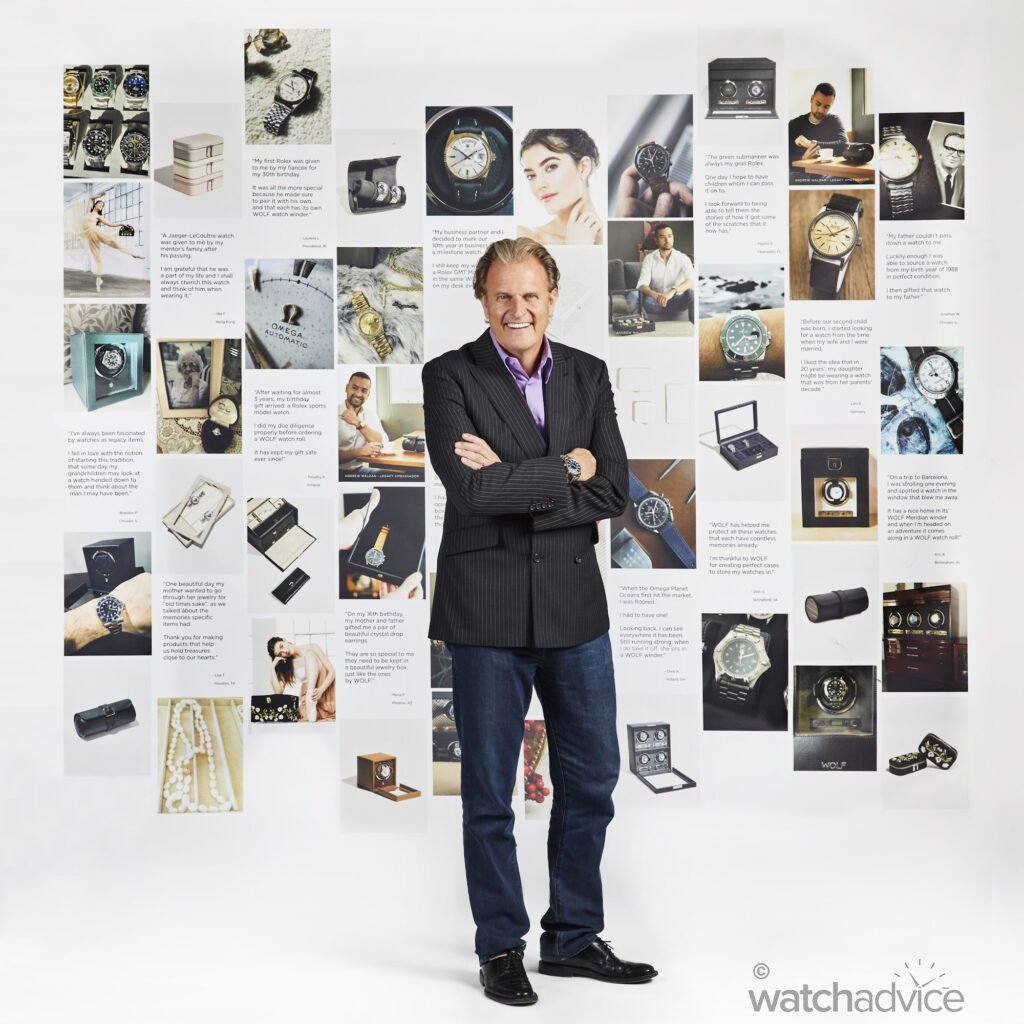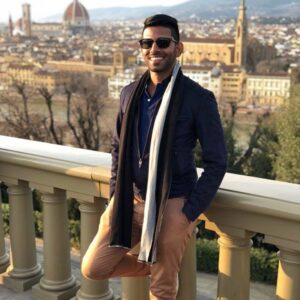Few leaders in the world of business and technology have been able to carve out a niche quite like Simon Philip Wolf V. He is the CEO and Creative Director of WOLF, a company renowned for its innovative approach to jewellery boxes and watch winders. Under Simon Philipp Wolf V’s guidance, WOLF has not only embraced the challenges of a dynamic market, but also set the benchmark for sustainable practices in the industry.
As WOLF is celebrating their 190 year anniversary in 2024, after five generations of ownership from the Wolf family, we had the opportunity to sit down with Simon Philipp Wolf V to talk not only about the history and future of WOLF but also his entrepreneurial journey and the many challenges he overcame to bring to what WOLF is today.
Simon Philipp Wolf V – CEO and Creative Director of WOLF
With a background that combines entrepreneurial spirit with strategic vision, Simon Philipp Wolf V has transformed WOLF into a powerhouse of innovation. His leadership style, as you’ll see throughout this interview, is very much team collaboration and forward-thinking, fostering an environment where groundbreaking ideas are given the room to flourish.
It certainly hasn’t been easy, however. During the early days of Simon’s career, he was entrusted by his father to create a brand new division in America. He’s had to use many of the “never give up” attitudes engrained in his DNA to persevere through the hard times and ultimately come out not only as a better leader but also taking WOLF to unseen heights.
“So we celebrated the 190-year anniversary in the Royal Opera House in London on June 4th. This is 190 years, with 5 generations of WOLF ownership celebrated with a product launch representing each generation. I am the 5th generation, and with that came a collection launch, which we launched here in Australia. What we did was we mimicked what we did in the Royal Opera House. Each of the five generations has a product, and I tell the story. I talk about my great-great-grandfather, who was a silversmith. He grew up in the business. He came up with the simple idea of putting his silver into boxes. And then other silver makers realised there was a business in that. You go back a 190 years, he was thinking about packaging. Today, the packaging is more a part of the sale than anything else. Back then, he was thinking outside the box! That’s how the genesis of the business started.“
“And then, his son moved to Sweden in 1905 and met an amazing woman called Ida, who married her in 1910. They had five kids, with two of them unfortunately dying due to Rickets and the Spanish Flu Epidemic. My great-grandfather retreated from life due to the death of the kids, as it was too much for him. Then Ida had to take over the business, and the only reason we are still here is because of this amazing, strong woman. She travelled all over Scandinavia to sell the boxes. Then, her first son, Philipp WOLF III, my grandfather, was really a very innovative guy who used lots of different techniques. In the 50s and 60s, he made all the watch boxes for all the watch brands before Richmont and LVMH came along. He was making it for Longines, Ulysse Nardin, Rolex, Omega, and all the big brands. We’ve uncovered some really amazing boxes from the archives, and the paperwork gives excellent provenance.”
“He also invented the ballerina box, the ballet dancer in the box. We haven’t done that for maybe 40 years. We’ve, however, recreated it for this 190-year celebration, made in walnut wood with the dancer sculpted ourselves. The backdrop is embroidered and beautiful.”
“My father was a very groovy fellow. He came to England in the late 50s, met my mother, married her after seven days, and then stayed in England. He designed great products in the 70s. We designed a product for this 190-year celebration, which is a remake of one of his products.”
“And then there’s me, and this is one of the products (shows the Earth watchwinder in brown on the table). My collection is dedicated to Earth, and it’s a collection of watchwinders, watch boxes and watch rolls. And it’s a very sustainable product. It’s made out of apple leather, and the lining is recycled material. And, of course, you don’t throw something like this away anyway, but it’s incredibly sustainable from that point of view. It’s controlled by the WOLF APP (the Watch Winder). I can stop it, rewind back to 12 o’clock, and control direction, rotation speed, and rotation numbers. For example, if you are wearing a Rolex Milgauss, and it requires 650 bi-direction rotations, it can be put on the app, and within 6 hours, the Watch Winder will do those rotations with sleep cycles in between. Afterwards, it will go to sleep for 18 hours, which makes up the 24-hour daily cycle.”
“Everything behind what we do is very well thought out in terms of the influences behind the watch. Because all watch brands have a turns per day specification, they specify what’s required. We have all that information on our website, so if you have a certain watch, you can look up the specifications, and it will tell you how many bi-directional rotations are required. It’s great for us because the watch brands give us the information, telling us all the data. We can then pass this knowledge on to our customers. For example, if you have an Omega Seamaster, it requires this many turns per day, and you can adjust the Watch Winder to do so. We are quite technical in the way that we design a product, and we also try to make it look fabulous and leave less of a footprint.”
WOLF’s history is a rare thing to see. Unlike other brands that have had an extensive history but have had periods where they stopped production or have had a change of ownership, WOLF has continued to push forward under the same family banner. As mentioned already, it all started with Simon’s great-great-grandfather, who saw the opportunity to make a product and business by selling boxes to store and protect silver jewellery rather than making the jewellery itself. This is similar to the times of the gold rush when there was a great business opportunity for those selling the digging equipment rather than spending countless days trying to look for the gold itself.
Touching on this topic, we asked Simon where his great-great-grandfather initially got the idea for creating jewellery boxes and whether he was the first one to do so!
“As I mentioned already, in the DNA, in that thread, there is a desire to make a box, and it started 190 years ago. I wouldn’t want to say he was the very first; I’m sure there were plenty of people making boxes. It’s more that my great-great-grandfather was able to turn these boxes into a full-on business. Again, making these boxes in the 50s, 60s, and 70s for the major watch brands validates who we are!“
“Through the archives, I have all the backup documentation. I have letters from Rolex, Longines, and Omega, where they are writing to my grandfather or the production guys saying, “We need to order this many boxes.”
“We’ve also changed so many times over the years. When you think about it, you have to change. Today’s world is so different from 20 years ago. It’s gone so rapidly. We’ve had to reinvent ourselves many times over.“
“Fifteen years ago, I realised that if I just made boxes that didn’t have much of a story behind them, if you didn’t make a reason for being, somebody else could just come along and do them as well. So I really focused on telling the story and not creating a brand because we have had all this history but making ourselves aware to everybody that we were a company that had been doing box making for so many years. Now, what you can see for the last 30 years, is on our website, our product, my contribution and my directional change.”
“My father did wonderful things, great things, but he wasn’t developing products that could be easily recognisable as “Oh, that’s a WOLF” or “it’s a brand I like or a brand that takes care of my watches or jewellery”. So what we are doing today is reinventing ourselves. For example, this is the first watchwinder with Bluetooth connectivity. We have the safes, we have the cabinets, and these pieces retail anywhere from 25,000 to 250,000 USD. It’s just in my blood to ask the questions. But it’s not easy. People think it’s easy. Why are we the best in our class? Why are we the brand that’s globally known with the distribution of 3,500 points of sale? We do all the trade shows; we have sales agents in every country, and we support our retailers, whether it’s an event. We do stuff like this. I’m not so interested in selling, but much more interested in the consumer and knowing what they want. I need to be able to share my story with the retailer so that they can then share this story with the consumer!”
When we first started, we were never watch journalists. We all started with different backgrounds, for example, Matt in Media and Sam in Civil Engineering. However, watches were our passion. Personally, I love the story of how the brand started and how certain products were created because that becomes part of the DNA of what makes you. Especially when you have a history, that’s as far back as WOLF, and at the end of the day, it’s still a family-operated business. So I think it’s really important to talk about that side of the WOLF. So you being now the fifth generation, how do you put your own spin on the product? How do you take the DNA of 190 years of WOLF history and put that into the products today?
“The fact that we are a family-owned business lends to our success quite a lot. It’s why we are still here—surrounding myself with really great people. I certainly can’t do it on my own. So, from my marketing team, Michael is our global sales director, and he lives on a plane. He loves what he does, at least I hope he does! There’s a very much family feel. When i went to the states in 1988, I didn’t know what the hell I was doing. I landed in Chicago. I worked there for four years trying to build the business. The small team I had almost became my family. Then, I went to Los Angeles and opened an office in Malibu. And that’s where it took off for me. I am a pretty gregarious person, and I’m very family-oriented. So they became my family, and that’s how it is in England.“
“We have an office in Hong Kong as well. That helps with the identity of the business. Because we all have this very common goal of respecting the brand and delivering it in all areas of the company. For example, our warehouse guys in any of the warehouses are really aware of what the brand is and is trying to be. They aren’t just shoving something in a box. For example, one of my employees, Jordan, who is in the UK, runs the warehouse there. He’s a young kid, and he really cares. He will see something and say we could do it better this way; we could try that. I certainly can’t do it on my own.”
“Another way to look at it is a watch, a car, your shoes, your tie, your jacket; you wear those things every day. It’s an outward representation of who you are by what you wear and how you carry yourself. However, when it comes to presentation boxes or jewellery boxes, you never take them with you. We have jewellery portfolios and watch rolls, but you never carry them on your person, showing them off. So I’m having to grab the consumer’s bandwidth and make a connection with them so that they go,” Huh, I identify with that brand, what they do is really good, their story is fantastic, so I’m going to want to own a WOLF.” One of the mottos we have on one of our youtube channels is “you don’t need a watch winder, you need a WOLF”. It’s presumptuous, but it’s where we want to be.“
I look at things like Watch Winders as a display case for watches, similar to the furniture in the house. It’s something that talks to you, and you will be sitting there holding your watches, which are worth tens of thousands of dollars. When it comes to protecting your timepiece, you don’t want something that’s cheap and flimsy. For one, you want something that works and is reliable, and two, you want something that looks good, for example, on your bedside table. If you have guests come over, they are going to see this product, especially if it’s sitting out in the lounge area. So, it needs to be aesthetically pleasing. I’ve seen watch winders that are quite ugly; they probably have a functionality similar to WOLF, but I see your products as a fusion between functionality and looks.
“It’s not easy to get to that point, however. To get people excited about it. Often, an analogy I use is: You have a lovely car; you don’t leave it on the pavement outside; you put it in a garage. You protect that investment or what you love. A big part of our story is protecting people’s legacy. There are very few things in life you pass on to your future generations. Great Jewellery and watches, whether they are of sentimental value, can be handed down through generations. They can be legacies. Our tagline is “Protecting your legacies”.”
“You take this sterling silver jewellery and you put it in one of my WOLF jewellery cases, and you open it 35 years later, it will be in the exact same condition.“
WOLF
“We protect the jewellery in our jewellery cases by having an inside lining in our jewellery cases that we treat with a solution that we came up with called LusterLOC, and what this does is it stops it from tarnishing. All metals eventually tarnish. Sterling silver tarnishes the fastest. You take this sterling silver jewellery, and you put it in one of my WOLF jewellery cases, and you open it 35 years later, it will be in the exact same condition. It completely stops the tarnishing process. So those things we try and engineer, it really does care for the product.”
“How LusterLoc works is very simple, and I don’t know why others don’t try to do it. I don’t have a patent on the process. I just have a chemist who came up with the combination of the elements that is a solution that you treat into the fabric. Then, you dry the fabric. All you are doing on the simplest level is closing the lid in the box, and the air inside is neutralised and basically acting like a sponge. So the ions that are inside the box in the “air”, they attach to the impurities in the metal and that is what causes tarnishing. So our solution can only last 35 years, because there’s a limit to how much it can last. But that’s a massive amount of time, regardless.”
Even though we are a watch publication, the reality is that a lot of the audience is men. But most of them have wives and girlfriends. Fifteen per cent of our audience is women, so things like jewellery boxes will certainly be of interest. Jewellery and watches can fall into a similar sort of market. For me, jewellery boxes can still be used for watches. Especially those with precious metals used for the case and bezel. It could effectively help protect those as well.
The biggest issue I have found with bronze watches is the patina. So to have something, you can put a watch on it to wind and protect them. However, its not just the jewellery boxes and watch winders, the travel cases are a perfect example of protecting your investment. If you take more than one watch while travelling, how do you plan to carry the second or third watch in your luggage? This is where the travel cases come in perfectly handy.
In my head, I think watch rolls are more modern. But the reality is that Simon’s father came up with the idea for watch rolls in 1985. What we wanted to find out was where this inspiration for this groundbreaking design of watch rolls come from? Was it from a personal need to protect his own watches while travelling, or could it have been that he’s seen a problem in the watch market that needed to be addressed?
“I was quite young then, so I don’t know the whole story behind it. I’ve skirted around the subject with him a few times, and he’s very nonchalant about it. But it was always about solving a problem. Like for example, I’m looking at a watch winder and saying, why do they always go on and keep going? Indeed, that’s not right. Talking to watchmakers in Switzerland, they say, “No, it should only have a certain amount of turns per day to take the mainspring to a certain amount of tension.” So then you say, how do I design the watch winders so that it only applies so much pressure to the main spring?”
“So, referring back to the watch rolls, my father would say I used to have a sock shoved into the watch’s bracelet, with another sock over it to protect the timepiece when travelling. Surely there’s a better way of doing this. My father was a very technical guy, too. He learnt how to fly. He had a pilot’s license when he was pretty young. He owned his own aircraft for many years, and he used it to travel back and forth to fly customers from London to Swansea to where our factory is. He also used to play the piano and guitar, and when he was a younger man, he was also a painter. So he certainly had creativity in him, and i think that brain allows you to feel more naturally outside the box to solve problems.”
Going back to Simon’s time in America to establish the brand there, his experience was one that was humbling but yet very rewarding. Initially he was given the go ahead by his father to set off to America from England and establish the brand there and in the Canadian market. This is not something that was easy. Breaking into a brand new market, even if you have a tested product may not always go as you have planned. This is what Simon shared with us recalling his time in America as a major learning curve, one that certainly tested his ability to persevere.
“It was crushingly difficult. When I went in 1988, we were still making products in English and Swedish factories. By the time we got 1990, we were having serious financial problems, we just couldn’t keep the factories going, so we had to shut a few down. This left me on my own in America without anything to sell because we were shutting the factories down. However, we were very fortunate that we went to a trade show in Hong Kong. I met a guy named Tony there, and he had a tiny factory with about 200 workers. We thought maybe he was a guy we could partner with to create WOLF products. Now, we are still partners with Tony, which is almost 30 years later! We have about 850 workers in the factory now, and they do everything very traditionally. However, the factory is based in now based in Shenzhen. About two years after partnering with Tony, he moved the whole factory into China.”
“But selling into America? Honestly, I was trying to get away from a girlfriend at the time I left to America. I was only 22, so I wanted to explore and have fun in America. Very quickly I realsied however, that i didn’t know anything. My father somehow saw something in me, but I didn’t understand what it was at the time. To this day, I’ve asked him about it numerous times, and his response has been, “You were going to be okay”. But even still, it was painful. Back then, there was no internet. I was trying to sell our jewellery boxes to department stores, to jewellery stores. There was a department store directory. It was a large book, with the inside being 100s of different department stores. So, I would call these stores and try to get to the right buyer. I did that for days and days. I was trying to find buyers so I could see them, tell our story and gain their interest.”
“I also realised that trade shows were a way of fast-tracking yourself in the market. I went to every single major market: Atlanta, Dallas, Chicago, and Seattle. I opened up with a sales rep group, the WOLF brand. But that country is really big, and just taking a bag of samples and going to New York sounds easy, but it’s not. It’s a five and half hour flight from Los Angeles. You get to New York, and the buyer you made the appointment with doesn’t show, and then you drag your bags up and down Fifth Avenue. It really was very difficult. However, that DNA in me of never giving up kept me pushing through! Even during financial problems, I sometimes went off on a tangent. I even tried becoming an actor and doing some modelling. I got an agent, but I could never get any work. I was desperate to get some money in the bank. But I just kept plugging on. I don’t think anybody else in my world did what I did to get to where I am.”
“By the late 90s, we had a perfect combination of new product design and a great factory that was making good quality products in China, and that just kept going and going until it kept getting more momentum. In the last decade or 15 years, there has been constant growth every year, and the magic of the people and the brand has been great.”
“We changed our branding as well to just WOLF. The day that I did that, it was extraordinary. When i put my business card on the table at Wathces of Switzerland all those years ago, they were really impressed with the logo design. I asked then why did you give me the appointment, and the rep at the time replied back with saying “I looked at the catalogue, i was really impressed, and the logo was just as impressive. If he comes to this appointment and the product looks as good as it does, actually feels in the person as good as it looks in the catalogue, then we’ll surely do business with him!”
There are lessons in that, for sure. At the end of the day, every successful person you talk to, at least very few of them, have had it easy. They more or less either started from scratch or inherited something, and it’s just been sheer tenacity to keep going. Matt was in Sydney and had a coffee with Bertrand Meylan from Moser & Cie, and he also said similar things. When they first bought Moser, it was almost bankrupt. They had no money, and for five years, they had cashflow problems. And he said that they kept going when most people would have just walked away. And I think that’s the difference between success and failure, just having the sheer tenacity to keep going, coupled with the total belief that it will work out. I think that’s what gives you the faith to keep going, the belief in the product or what you are trying to sell. If you didn’t believe it in the first place, you would most likely give up at the first signs of struggle.
“And it’s true, as they say, most entrepreneurs have failed way more times than they’ve succeeded. I’ve stubbed my toe way more times than I can remember. And this is what you learn from, so you know what to do next time so you don’t keep making the same mistakes. I also make it fun within the business. I say this, however, and wonder what they say behind my back! We have a lot of great people making the vision come true. We have about 60 people in the company with three offices, and then all the sales agents outside of that, about another 60 people. You’ve got to make it fun! If it’s not fun, then you just gotta do something else. Don’t be here.”
“And, of course, not every part of the business is glamorous and fun. Is it fun being in customer service? Having to deal with customers all day. Is it fun doing numbers as an accountant in the business? Is it fun packing boxes? It’s what you do more than anything else, so if I can add a layer of what we do, we never take ourselves too seriously; it can go a long way in creating less stress in the business. I never take things too seriously. We do a lot of activities. Last year, I had everybody from the LA office come to the UK office, and then everybody in the UK office went to the LA office just to see what it was like. Indeed, not all the staff at once; otherwise, the business wouldn’t run. However, if you were in customer service, and if you were in the warehouse, they would go to America to the LA office, and the exact same staff with the same responsibilities in the LA office would go to the UK office.”
“The warehouse guys like Jordan, Luke, and Charlie have repeatedly said that “we have never worked in any of the other businesses in this type of environment. We have never even been part of business meetings, let alone go visit other offices overseas.” I want them to know what’s going on in the business. If there’s a customer that walks around through the business and we go into the warehouse, I always introduce them to the employees and tell them who these guys are, and never disregard them. I mean, I can pack a box well, but I can’t do that and everything else, so they are an essential part of the business. So, I try to make it as fun as I can.”
As we reflected on WOLF’s journey through 190 years of history, it was intriguing to understand how Simon envisions his legacy to this business and his aspirations for it. He has shown that he has a deep commitment to creating a culture of innovation and sustainability while also creating a team environment where everyone understands and believes in the vision so that they can all work together to achieve the company’s goals.
“It would be building something that can stand the test of time. To build something really solid. Im a very insecure and paranoid person, so i always worry about building a company that solid enough to manage without me. Do we have enough customers and are they paying their bills on time? I want to build a system that is so strong. I am always so impressed by big business where it just works effectively, especially at such a huge scale. Our goal as a company is to be a $100 million globally. We are almost halfway there, closing in on $50 million. Creating the business as a brand that hopefully everybody who wants a watch winder or jewellery case will go “Yeah, maybe I’ll get a WOLF”. If i can get to that point, that would be the perfect legacy i can leave bending and be proud off. It’s such a huge part of what I’ve been doing, and I love it so much.”
In discussing WOLF’s presence in Australia, we asked Simon how the company is navigating the challenges of vast land with a relatively small population. He shared insight into the unique opportunity Australia presents, highlighting the watch communities in the different major cities. This isn’t the first time WOLF has tried to establish itself in Australia. Like any new market, they have had their share of ups and downs here.
“Its an exciting market. If I rewind to 15 years ago when we had no representation here in the land down under, Australians will come into our website, and you guys were always in the top 10 in the most visited countries to us. It’s unbelievable. And you would either order multipiece wonders that would cost a fortune to ship from our warehouse in England or LA. You really are the community or country where it is really nerdy and into watches. And you’re part of the bigger jigsaw puzzle, but you are also an interesting piece.”
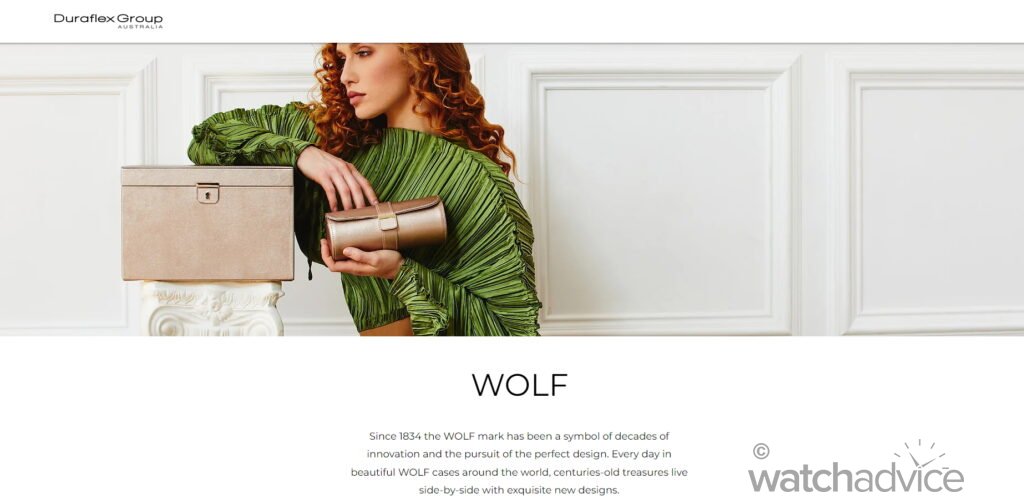
“The potential is really lovely. We’ve had so many mis-starts here. We’ve had another distributor here in Australia who messed us up for a while. Meeting Phil and DGA and how he treats his customers and just going to see them, you can tell that they love working with the product. It’s about building the brand here to make WOLF more accessible to the watch and jewellery community. So you can walk into a store and find WOLF products on the shelf. It can take a few years, but we’ll get there because we have the right partners to work with now!”
As we wrapped up the interview, we asked Simon to indulge us with his favourite part of WOLF’s journey over the past three decades. He recalled the pivotal moments of innovation and growth that shaped the company’s identity, emphasizing the strong community of employees and customers that has been integral to its success. As with any startup or new project, the importance of resilience cannot be understated. The willingness to pivot in response to market changes and the road to success are often paved with challenges and opportunities, which are just a few things that ring true in Simon’s entrepreneurial journey.
“It has to be the people; it’s the people I get to work with. There can be moments when they let you down, and it can be painful. But who I work with and how they have committed to the mission is just astonishing and very humbling. I work with people who work so hard and bring so much, and that’s amazing. I’m very lucky to have this group. If you don’t have a good team around, you can’t do anything.”
“Regarding the advice, it’s a short question with such a long answer! I think the best thing i can say is that if you believe in yourself, and what it is you’re trying to do, you just never never give up. I mean just looking at my story, i built a fairly substantial business, I’ve got three offices and all these people working for me, and at the end of the day, I make a box! It’s a six-sided box, and you think, come on, anyone can do that, but actually, to do it to the level that I’m doing it, it’s rather difficult! So, believing in yourself and what you set out to do is going to work! You may come across instances where you think that you may be doomed. But you cannot ever think to yourself that you are! If I ever had thought that I couldn’t make it work, especially my time in America, I would’ve given up, and the company wouldn’t exist, especially during the times when we were going through financial troubles.”
Reflecting on our conversation with Simon Philipp Wolf V, it’s clear that he has all the right qualities to lead WOLF into new horizons. His insights into leadership, legacy, and the evolving landscape of business provide a compelling narrative not just for the company but for the industry as a whole. Simon’s commitment to creating a culture of creativity and sustainability ensures that the company is well-positioned for the future. With a visionary leader at the helm, the next chapter of WOLF’s journey promises to be just as exciting as its storied past.


